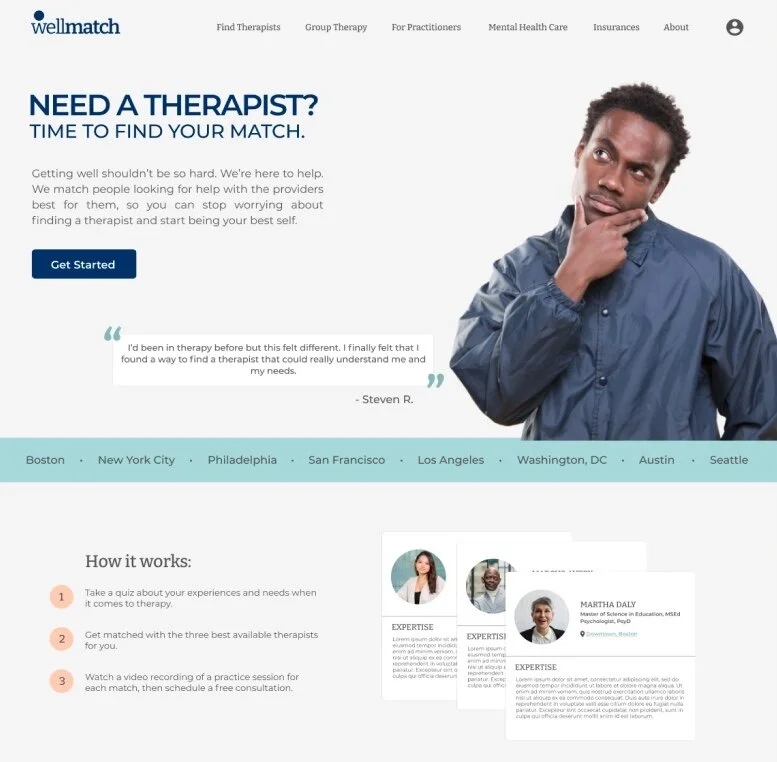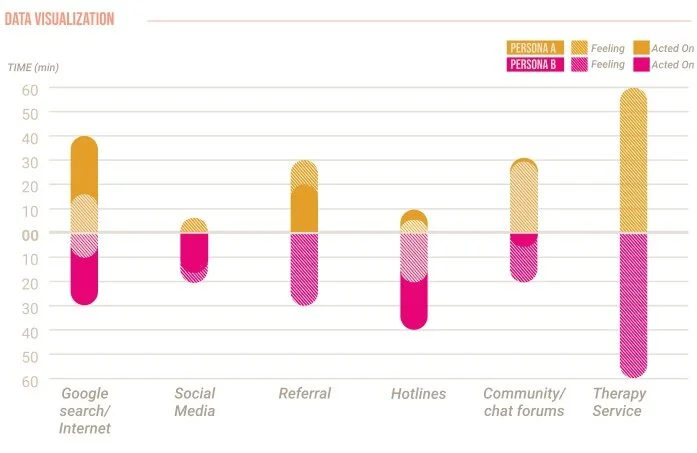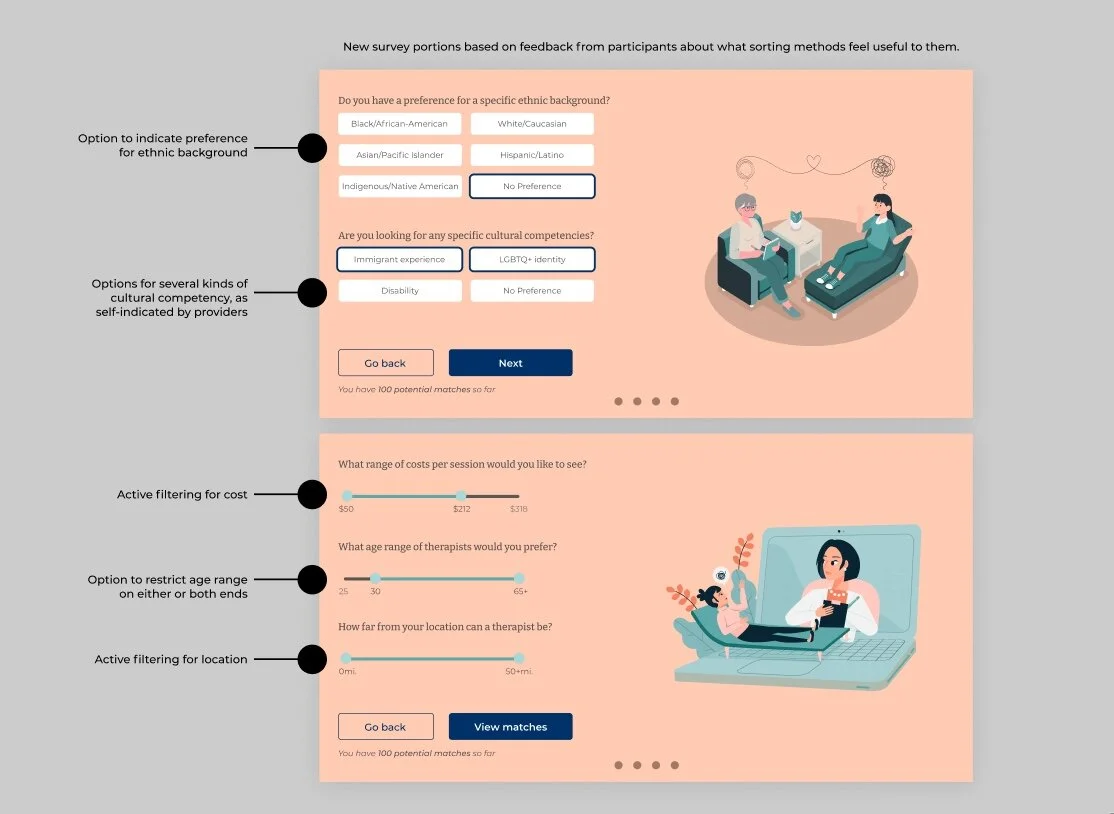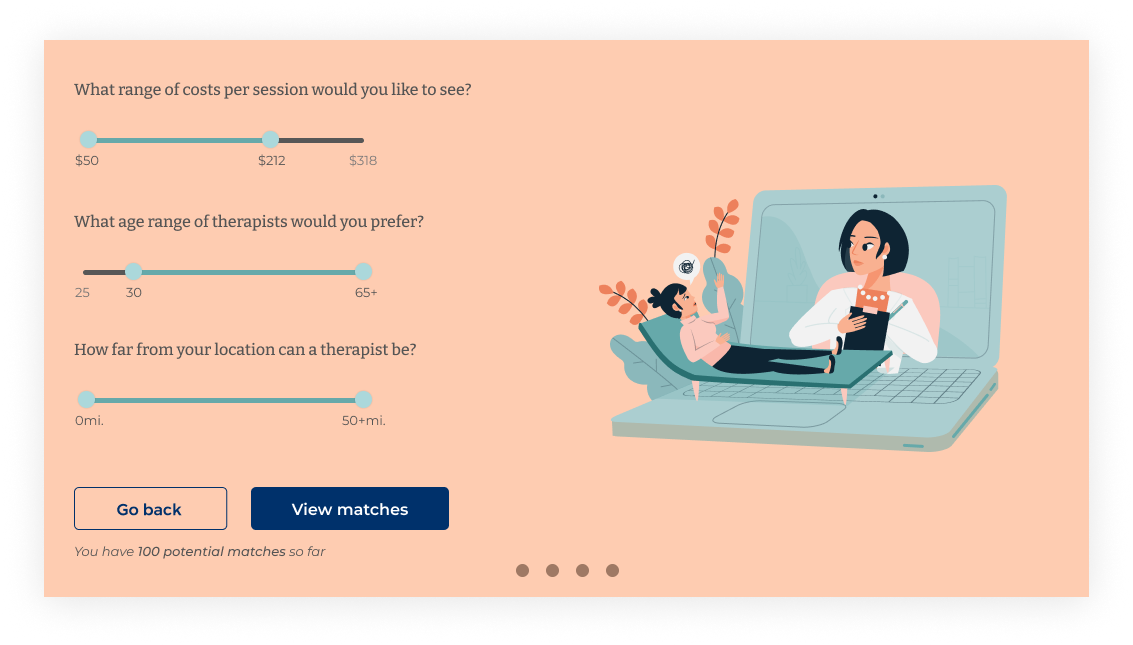wellmatch
Mental Health Matchmaking
wellmatch helps people find the best therapists for their needs and preferences easily.
ROLES
Product Strategy
User Research,
Visual Design, Prototyping
TEAM
Dee Williams
Niyati Kothari
Ragini Srikrishna
BACKGROUND
Individuals seeking mental health support face a variety of barriers in finding a therapist who match well with their needs and personal preferences. In order to help these individuals make their search painless and fruitful, we interviewed stakeholders and conducted precedent research to identify key issues, and designed a platform targeted at adults seeking therapy relationships.
“The first few times when I went for therapy...I was not very comfortable. I thought she had not understood me completely.”
PROCESS
Our design process began with observation starting with our own experiences and that of family and friends. We also spoke to a handful of social workers to garner their perspectives. These initial observations made it amply clear that most people faced a variety of issues in accessing metal health treatment. We then set out to determine what those specific barriers were by interviewing five participants whose inputs were captured by coding the interviews based on their pain points and pleasure points.
All interviewees were between the ages of 20 and 30 and lived in cities (Boston, Columbus, Mumbai & New York). All were college-educated and had sought mental health treatment, for a variety of reasons. Prior to the interviews, we developed an interview guide with categories of questions as well as privacy guidelines.
The transcripts of the interviews were analyzed using a coding schema that relied on the unit of responses to each question. Long responses were broken into paragraphs that were then analyzed and anonymized. Two of the interview transcripts were coded as a group enabling us to talk through and resolve any discrepancies within our team. Subsequently individual coding of the remaining were done with a final resolution session of any uncertainties.
“I think the reason I seek that is because I need someone who understands that I have a different culture.”
INSIGHTS
The interview participants used a variety of ways to try and fight a suitable therapist. They found that process of finding the right therapist to be like dating. They saw several and it was unclear if any of these were the right one. They chose to continue with the ones that seemed to check some of the right boxes. We were able to learn about the specific barriers and needs people faced through our interviews. Particularly, there was a focus on cost-effectiveness, worry/stress caused by the search process, and comfort people desired to feel with their therapist.
Based on these interviews, we developed personas to help identify the kinds of solutions that might be appropriate to address the challenges they faced. Our precedent research was guided by these personas and served as an inspiration for different aspects of the solution that we would design. Subsequently we created a prototype of our platform and conducted user testing to determine the aspects of our final design.
PRECEDENT STUDY
Based on the insights garnered from our interviews, we focused our precedent study with the aim of reducing the time, cost and effort an individual would have to put in.
Time How long does it take to find a suitable therapist?
Cost How much do I have to spend in terms of money?
Effort How much effort do I need put in?
These three will determine a fourth tenet:
Stress How stressful will this whole process be?
The effectiveness of seeking therapy or seeking a match cannot come at high stress.
Competitive analysis We visualized this problem of finding a suitable therapist as a matching problem, not unlike those seen in job search and dating applications. We studied around 20 different applications and platforms including those providing mental health support such as Headspace and Tryframe, and dating applications such as Hinge and Bumble. We created a chart (below) to identify an overview of the key features as a reference and map down our next steps.
CONCEPT
In the real world, as our interviews revealed there is no easy way to find the perfect match for your mental health needs. This problem is more acute for people of color who had to try out several therapists often settling for something less than ideal.
wellmatch our proposed platform, seeks to address this core issue by improving the probability of a good match. The customer is in in charge of their access. Our users tell us what they need. We provide them options and free consultations.
No more settling for less.
After filling out a survey, users will be provided matches that align with their needs from cost to fit. Each user will receive free consultations to therapists they match with. After their consultations, users can anonymously share and rank their experiences.
PROTOTYPING
We aimed to address two core issues cultural competency and choice anxiety by establishing a platform that incorporates a data matching algorithm and sample therapy videos for our users.
Matchmaking is affected by gender, age, and income. While they may not necessarily predict a therapeutic alliance, these factors play a significant role in users' decisions to even choose a therapist to meet. Study subjects desired nudges and varied options for these preferences.
Utilizing customization by providing enhanced navigation and algorithm elements are popular as people were comfortable with them.
Multiple-choice surveys as a tool are effective only if the necessary questions and answers are in an easy format with a variety of options.
wellmatch
Our final prototype, made in Figma is shown below. The video showcases a typical user navigation path through the wellmatch portal.
LEARNINGS
Each member of our team was passionate about improving mental health access for all. As we got rolling on the project, we each brought different strengths and experiences to the execution. My undergraduate research experience as a psychology major helped connect us to front-line mental health workers for interviews. As an illustrator I was able storyboard our findings from the interviews and create customer journey maps. In turn I learned about coding and quantifying our qualitative data and consistent visual language from my team mates. These skills played well into our final prototyping and presentation of our solution.
The entire experience brought home the criticality of user personas and needs and the need for iterative prototyping and user testing. While this entire exercise was done over the course of three months, I could easily see portions of this process being done in three week sprints with future teams.











